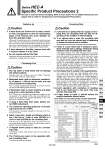
7-p1379-1411-hec_en@@@18 / 34
10bÐèBOOKäy[WèÖÛçÉñ
Circulating Fluid Circulating Fluid Caution Caution Radiation Air Caution Series HEC-A Specific Product Precautions 2 Be sure to read this before handling. Refer to front matter 41 for Safety Instructions and pages 1246 to 1249 for Temperature Control Equipment Precautions. 3. If more than one Thermo-con is used, consider their arrangement so that the downstream sides of the Thermo-cons suck radiation air from the upstream sides. Otherwise, the performance at the downstream sides may deteriorate. Also, the set temperature may not be achieved depending on the value of the set temperature and the load. In such a case, take countermeasures such as changing the direction of the Thermo-cons to prevent the deterioration of performance. 4. If dust adheres to the filter, remove dust with a vacuum cleaner or a dry cloth. 5. Do not operate without the filter. Otherwise, dust may accumulate on the heat sink and electrical components, causing abnormal heating. 1. Use tap water or fluid which will not damage the wetted material. (Stainless steel 303, Stainless steel 304, EPDM, Polypropylene, PE, PPE, Ceramics, Polyurethane) 2. Deionized water (with an electrical conductivity of approx. 1 òS/cm) can be used, but may lose its electrical conductivity. Also, if a facility supplying deionized water is used, the Thermocon may be damaged by static electricity. 3. If deionized water is used, bacteria and algae may grow in short periods of time. If the Thermo-con is operated with bacteria and algae, its cooling capacity or the capacity of the pump may deteriorate. Exchange all deionized water regularly depending on the conditions (once a month as a guide). 4. If using a fluid other than water, please contact SMC beforehand. 5. The maximum operating pressure of circulating fluid circuit is 0.1 MPa. If this pressure is exceeded, leakage from the tank in the Thermo- con can result. 6. Select a pipe with a length and diameter which allow a flow rate of 1 L/min or more (HEC002) or 3 L/min or more (HEC006) for the circulating fluid. If the flow rate is less than these values, the Thermo-con cannot provide precise control, but also can fail because of the repeated cooling and heating operation. 7. A magnet driven pump is used as a circulating pump. A fluid which contains metal powders such as iron powder cannot be used. 8. The Thermo-con must not be operated without circulating fluid. The pump can break due to idling. 9. If the tank lid is opened after the supply of circulating fluid, the circulating fluid may spill out depending on the condition of external piping. 10. If an external tank is used, the circulating fluid may spill out from the internal tank lid depending on where the external tank is installed. Check that the internal tank has no leakage if using an external tank. 11. If there is a point where fluid is released to atmosphere externally (tank or piping), minimize the piping resistance at the circulating fluid return side. If the piping resistance is too large, the piping may be crushed, or the built-in circulator tank may be deformed or cracked because the pressure in the piping for return will become negative. The built-in circulator tank is made of resin (PE). Therefore, the tank may be crushed if the pressure is negative. Special attention must be paid if the flow rate of the circulating fluid is high. To avoid getting negative pressure less than .0.02 MPa, the piping for return should be as thick and short as possible to minimize the piping resistance. It is also effective to restrict the flow rate of circulating fluid or remove the gasket of internal tank for the release to atmosphere. 12. Fluorinated fluid is outside of the specifications. If it is used in the Thermo-con, static electricity will be generated by the flow of fluid. This static electricity may be discharged to the board of the Thermo-con, causing damage or operation failure and loss of data of such as set temperature. Also, as the specific gravity of the fluorinated fluid is 1.5 to 1.8 times of water, the pump will be overloaded, which also causes fluorinated fluid to be outside the specifications. Therefore, if fluorinated fluid is used, please contact SMC and we will introduce a suitable special product (water-cooled type). 13. Avoid operation with cavitation or bubbles due to low fluid level in the tank. This may shorten the pump life. 14. If clear water is used, it should satisfy the quality standards shown below. Standard item Reference item Item pH (at 25C) Electrical conductivity (25C) Chloride ion (Cl.) Sulfuric acid ion (SO4 2.) Acid consumption amount (at pH4.8) Total hardness Calcium hardness (CaCO3) Ionic state silica (SiO2) Iron (Fe) Copper (Cu) Sulfide ion (S2 .) Ammonium ion (NH4 +) Residual chlorine (Cl) Free carbon (CO2) Unit . [òS/cm] [mg/L] [mg/L] [mg/L] [mg/L] [mg/L] [mg/L] [mg/L] [mg/L] [mg/L] [mg/L] [mg/L] [mg/L] Standard value Influence Corrosion Scale generation 6.0 to 8.0 100. to 300. 50 or less 50 or less 50 or less 70 or less 50 or less 30 or less 0.3 or less 0.1 or less Should not be detected. 0.1 or less 0.3 or less 4.0 or less ÞÝ ÞÝ ÞÝ ÞÝ ÞÝ ÞÝ ÞÝ ÞÝ ÞÝ ÞÝ ÞÝ ÞÝ ÞÝ ÞÝ ÞÝ ÞÝ ÞÝ . In the case of [MÑÞcm], it will be 0.003 to 0.01. Þ ÞÝ: Factors that have an effect on corrosion or scale generation. Þ Even if the water quality standards are met, complete prevention of corrosion is not guaranteed. Clear Water (as Circulating Water) Quality Standards The Japan Refrigeration and Air Conditioning Industry Association JRA GL-02-1994 gCooling water system . Circulating type . Supply waterh 1395 HRG HRS HRZ HRZD HRW HEC HEB HED HEA IDH